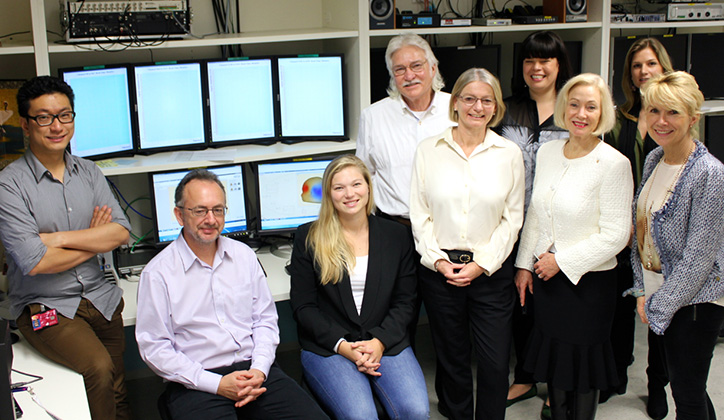Last Wednesday was an exciting day for Associate Professor Blake Johnson, Distinguished Professor Stephen Crain and David Meng of the ARC Centre of Excellence in Cognition and its Disorders (CCD). After months of preparation, their first clinical study in the new cochlear implant MEG device was ready to begin – with a high-profile participant.
Jamie-Lee Lewis, Hear and Say ambassador and daughter of Rugby League legend Wally Lewis, visited the University for the inaugural clinical use of its world-first Cochlear Implant (CI) MEG scanner.
In a joint project between the CCD and Hear and Say Queensland, the research team is using the magnetoencephalography (MEG) brain imaging technique to measure brain function in recipients of cochlear implants, including young adults like Jamie-Lee.
They’ll also be joined by linguists Associate Professor Rosalind Thornton and Kelly Rombough to investigate behavioural characteristics of implant recipients.
Johnson is curious to see what Jamie-Lee’s brain scans reveal. “We will be looking at how Jamie-Lee’s brain responds to speech and other sounds compared to that of a person with normal hearing,” he says. “Jamie-Lee is particularly interesting as a subject because she was deaf before she acquired language. It will also be interesting to compare her brain’s response with those of children who received implants at earlier ages.”
According to Distinguished Professor Stephen Crain, Director of the CCD, “We know that early intervention yields the best cognitive outcomes for children, but the human brain has amazing adaptive abilities at all ages. Using the new MEG system, we are investigating how the brain is able to achieve so much using the information provided by a cochlear implant.”
Significantly, the installation of the CI MEG device is also one of the first major outcomes of the Australian Hearing Hub, an initiative of Macquarie University that brings the country’s best hearing technology and research providers together with allied health organisations. The CI MEG itself is the result of collaboration between the CCD, Cochlear Limited, the Hearing CRC, CSIRO and Kanazawa Institute of Technology.
According to Associate Professor Jim Patrick, Chief Scientist at Cochlear, “It is a great example of what can be achieved by partners in the Australian Hearing Hub.”

